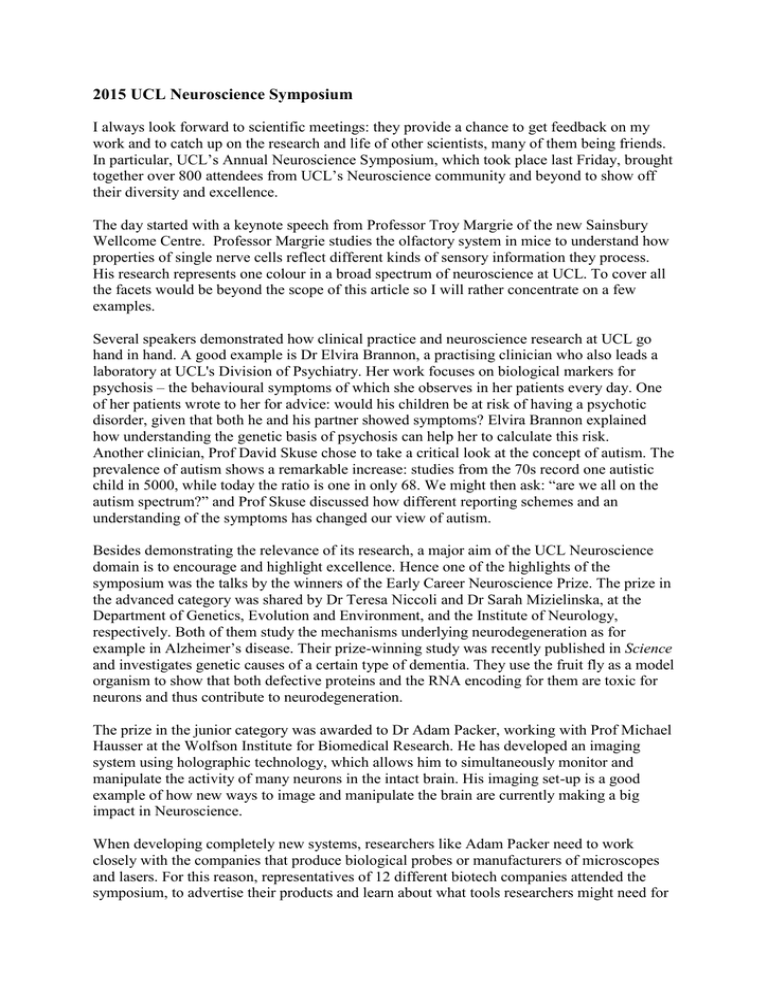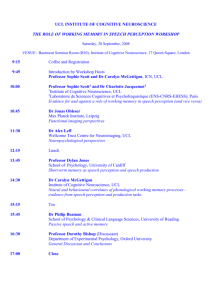2015 UCL Neuroscience Symposium
advertisement

2015 UCL Neuroscience Symposium I always look forward to scientific meetings: they provide a chance to get feedback on my work and to catch up on the research and life of other scientists, many of them being friends. In particular, UCL’s Annual Neuroscience Symposium, which took place last Friday, brought together over 800 attendees from UCL’s Neuroscience community and beyond to show off their diversity and excellence. The day started with a keynote speech from Professor Troy Margrie of the new Sainsbury Wellcome Centre. Professor Margrie studies the olfactory system in mice to understand how properties of single nerve cells reflect different kinds of sensory information they process. His research represents one colour in a broad spectrum of neuroscience at UCL. To cover all the facets would be beyond the scope of this article so I will rather concentrate on a few examples. Several speakers demonstrated how clinical practice and neuroscience research at UCL go hand in hand. A good example is Dr Elvira Brannon, a practising clinician who also leads a laboratory at UCL's Division of Psychiatry. Her work focuses on biological markers for psychosis – the behavioural symptoms of which she observes in her patients every day. One of her patients wrote to her for advice: would his children be at risk of having a psychotic disorder, given that both he and his partner showed symptoms? Elvira Brannon explained how understanding the genetic basis of psychosis can help her to calculate this risk. Another clinician, Prof David Skuse chose to take a critical look at the concept of autism. The prevalence of autism shows a remarkable increase: studies from the 70s record one autistic child in 5000, while today the ratio is one in only 68. We might then ask: “are we all on the autism spectrum?” and Prof Skuse discussed how different reporting schemes and an understanding of the symptoms has changed our view of autism. Besides demonstrating the relevance of its research, a major aim of the UCL Neuroscience domain is to encourage and highlight excellence. Hence one of the highlights of the symposium was the talks by the winners of the Early Career Neuroscience Prize. The prize in the advanced category was shared by Dr Teresa Niccoli and Dr Sarah Mizielinska, at the Department of Genetics, Evolution and Environment, and the Institute of Neurology, respectively. Both of them study the mechanisms underlying neurodegeneration as for example in Alzheimer’s disease. Their prize-winning study was recently published in Science and investigates genetic causes of a certain type of dementia. They use the fruit fly as a model organism to show that both defective proteins and the RNA encoding for them are toxic for neurons and thus contribute to neurodegeneration. The prize in the junior category was awarded to Dr Adam Packer, working with Prof Michael Hausser at the Wolfson Institute for Biomedical Research. He has developed an imaging system using holographic technology, which allows him to simultaneously monitor and manipulate the activity of many neurons in the intact brain. His imaging set-up is a good example of how new ways to image and manipulate the brain are currently making a big impact in Neuroscience. When developing completely new systems, researchers like Adam Packer need to work closely with the companies that produce biological probes or manufacturers of microscopes and lasers. For this reason, representatives of 12 different biotech companies attended the symposium, to advertise their products and learn about what tools researchers might need for their experiments. In addition, a special workshop on “Multiphoton microscopy and the neurosciences” was sponsored by Coherent. My personal highlight was the poster sessions: as a presenter, I valued the discussions and feedback on my research; as an observer, I got the chance to learn something new and ask questions. A total of 138 researchers presented their work, and the exhibition halls were packed with people who wanted to see it -- some discussions at the poster boards continued long after the sessions had started again. In addition to individual research posters, the UCL Neuroscience Symposium featured a competition of lab posters that introduced the research agenda of whole laboratories. The winning poster came from the group of Dr Maria Chait (at the UCL Ear Institute), working on how the brain makes sense of sound, with the runner-up by Prof Patricia Salinas’ lab (at the UCL Department of Cell and Developmental Biology), who is trying to understand the mechanisms that trigger the degeneration of nerve cell contacts and their recovery. The day finished with a keynote talk by Prof Yang Dan, who was visiting from the University of California, Berkeley. She described the neural mechanisms that underlie different brain states, such as sleep and wakefulness. She provoked by far the most questions from the audience and stimulated a lively discussion, providing an appropriate climax to the symposium. Had I been wondering why I chose to study Neuroscience at UCL, Friday reminded me of it: the symposium really demonstrated the diversity of research, and in particular collaborations in the Neuroscience domain, and I left it with a feeling of excitement. Blog by Lea Goetz, PhD Student at the Wolfson Institute for Biomedical Research

